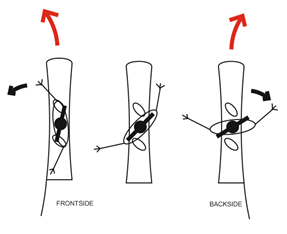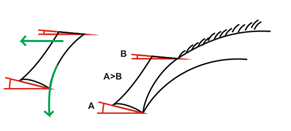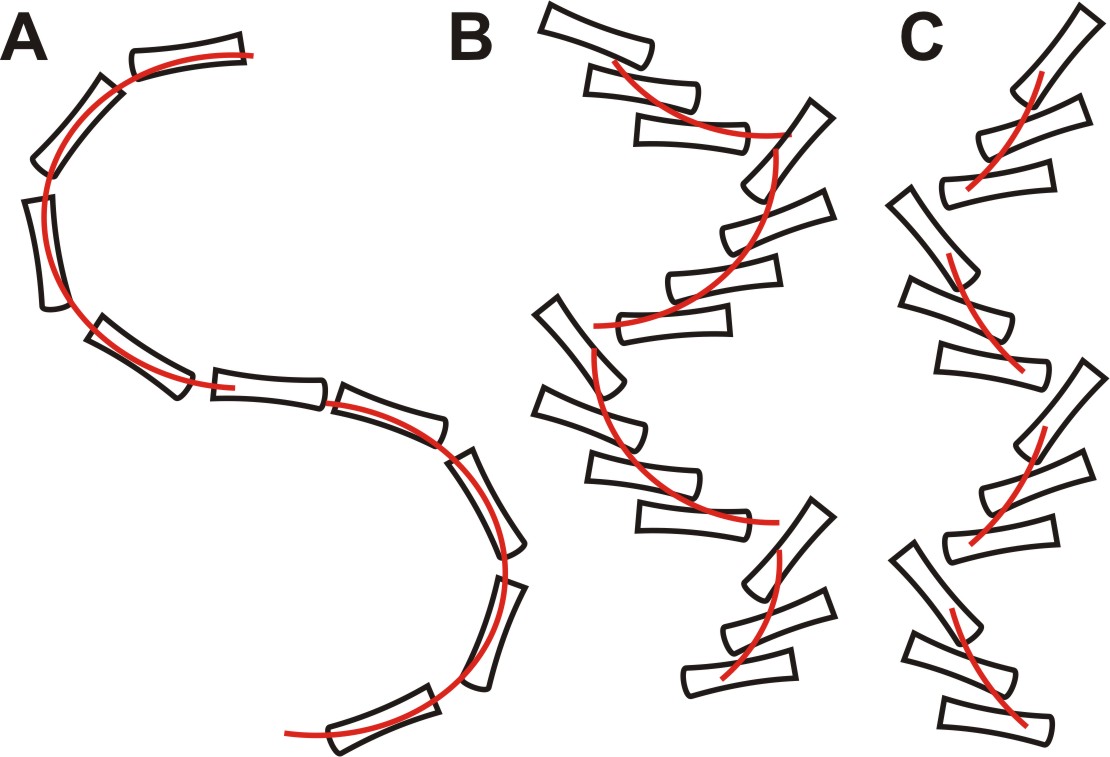

How does the board turns?
The answer looks to be simple. The edge is a curve, the board is narrow in the center and has a wider nose and tail, the edge is a curve like part of a circle. If we increase a load of boards edge, by moving our center of mass, board should turn.
But it is not the only possibility.
Below, we will analyze other elements that affect board turning. All of them affect as a change of board track direction, but not all of them can be called "a turn"...
1) Weight move.
The simplest way is to move your weight in a forward-backward plane. When the board is pointed across the hill and our weight is centered on board, it will be no turning. If we will move our weight forward, the nose of the board will be falling down the hill. When a board is pointed down the hill, we can move our weight backward, to have tail falling down the hill. When the board is pointed across the hill we can center our weight.
For such turn, board do not need to have sidecut/carving shape. Edge could be straight.

2) Forced turn - counter-rotation
In this case, we use our torso inetria, to slide tail of board outsice by a rear leg. This is "automatic move" like trying to avoid falling, performed by most of the snowboarders, especially on steep slopes.
It is one of biggest and most difficult to correct mistakes in snowboarding, wich not let you ride pure on-edge carving turns.
It is a dynamic rotation of your torso against board turn direction.
More you can find in an article about counter-rotation

3) Less force needed - rotation.
A turn that we initiate by our torso rotation in board turn direction. The board can be angled/tilted a little or transversely twisted (decribed below). It is also able to be performed when the board runs flat, using torso rotation inertia.

4) Transversely twist of board.
If we will twist board like a propeller by our knees, to have the nose of board angled more than tail, the more angled part of board will start "catching edge". Nose part of the board will try to move in a circle, which depends on board sidecut radius. But the tail part of the board will be almost flat, so will slide outside, so nose-part radius of turn will be greather than the nose part of the board. Such a twist of the board and its behavior is the effect of the torso rotation described above. It depends on our physique, anatomy. If you will stand in "snowboard position" and rotate frontside, your front hill will go up. For backside rotation, front toes will go up. But you can also do it without/minimal torso rotation... The effect is slide turn od board.

5) Tilt/angle the board.
If you will strongly tilt/angle the board, it will bend, due to its construction and geometry (wide nose and tail, narrow center). It will bend to all edge contact the snow. And the line of this contact will be a part of circle. The greater the angle, the smaller the radius of the circle.
This is how the board rides on-edge carving turns. If the angle is big (and weight centered) board will ride on-edge turn, but the smaller the angle (and weight not centered) the higher possibility of a slide.

How yo use it?
Which described above elements are good and which not? For sure, definitely the wrong thing is counter-rotation. All the rest of them are good, some of them very good, some of them "less good". It depends on which point of learning of carving you are.
Sliding turns - different approaches.
Sliding turn is the first turn that you will learn. We can observe two main approaches on how to do it.
First is a Rotation approach. Is the summary: move weight forward and then rotate torso towards board rotation. There is one important thing here, which is not visible at first glance. When rotating torso backside weight is moved forward the board, when rotate on frontside, weight is moved backward, closer to board tail. It is important for frontside sliding turns to move weight closer to board nose.
Rotation sliding turn has one, but a big disadvantage. Most of riders, ends learning of snowboard with instructor here. Because on this level, they can turn, so for a lot of people it is enough to tell "I can snowboarding". This evolution is being learned on almost flat slopes. When such rider will go much steeper slope, will use rotation only as preparation of torso position for counter-rotation, which is on of biggest mistakes in technique and really hard to correct. It will not allow your board for smooth on-edge carving turn...
Second approach is no-rotation. You can see it for example on SnowProfessor yotube channel. Instead of torso rotation, we can use here only our knees and twist board by them. For frontside, move front knee towards snow, for backside move it outside and lean on highback. Some small rotation of hips will appear but it is an effect of knees movement. But this move will affect the board almost the same way as a torso rotation.
On-edge carving turns.
It looks so easy... If we can perform sliding turns without rotation, we just need to tilt more the board by our knees.
But how to tilt it? At first twist and then tilt? Angle whole position inside the turn? Or do it only by legs/knees/hips? Rotate or no?
The best way is to do it in a sport/race way "to tilt board as much and as fast we can" during turn beginning. At first angle the board using legs and have torso positioned vertically and when board will start to turn, angle your whole position inside turn. Or better try to "break position" in hips like racers do. For backside almost lay chest on knees, for frontside put knees and hips inside a turn, trying to keep shoulders horizontally, a position called "banana style".
Such "break position" can be seen on Midweighting youtube channel: "Begining a turn" video. Starting a turn by angle os board by legs, you can find also in another SnowProfessor video: "How to Snowboard-Basic Carve".
When you try to initiate of turn by an angle of the whole position inside a turn, there is quite a lot of time until board angled enough to go "on-edge". Especially if your position is not perfectly centered. During this time, there could lot of things happen... some of them may cause by slide instead of on-edge ride... So better to tilt the board fast by legs and then angle inside the whole position, to minimize time when the board is not angled enough.
Should we rotate? We can use some rotation, but it can not be too big, not to twist the board. For on-edge carving turns, board should not be twisted. That's why racers are using strange kinds od plates like Allflex or Iron Rock.
What is a "turn"?
Thing that looks to be obvious... When you are riding straight down the hill and suddenly you will change board position by pushing your rear leg outside. Is this a turn? In our opinion - no.
For us, a turn, is a maneuver that board is turning smoothly, moving in a curve close to circle, where boards axis is all the time tangent to a curve that moves - curve that is close to a part of circle. And track behind the board is a symmetrically curve also close to a circle. It is not important here if it slide or ride on-edge.
If our track on snow behind a board is not a smooth curve, but not symmetrical, broken curves or even some straight lines, it means it is no a good turn, or even it is not "a turn".
Picture below shows that. Only track on the left, shows a smooth turn where the board is going in a circle. Such track will help you a lot to learn on-edge carving turns.



REMARKS:
Notice that SnowboardAcademy.pl website contents only chosen aspect of snowboarding. This is not an complex publication "how to snowboarding". The authors are responsible for any individual attempts of performing descibed snowboading elements of technique or equipment adjusting.
All rights reserved. Copyrights SnowboardAdacemy.pl
This website and it content are legally protected by Polish Law, currently effective Act on Copyrights and Related Rights.
Copying and further publication of its contents without a prior author's consent and source (www.SnowboardAcademy.pl) indication is strictly forbidden.
e-mail: info@shaman-snowboard.pl
|





